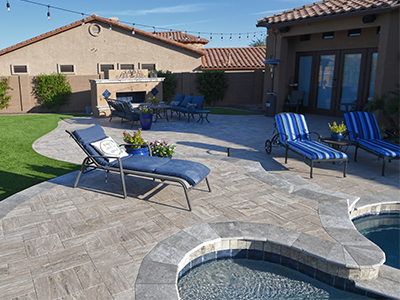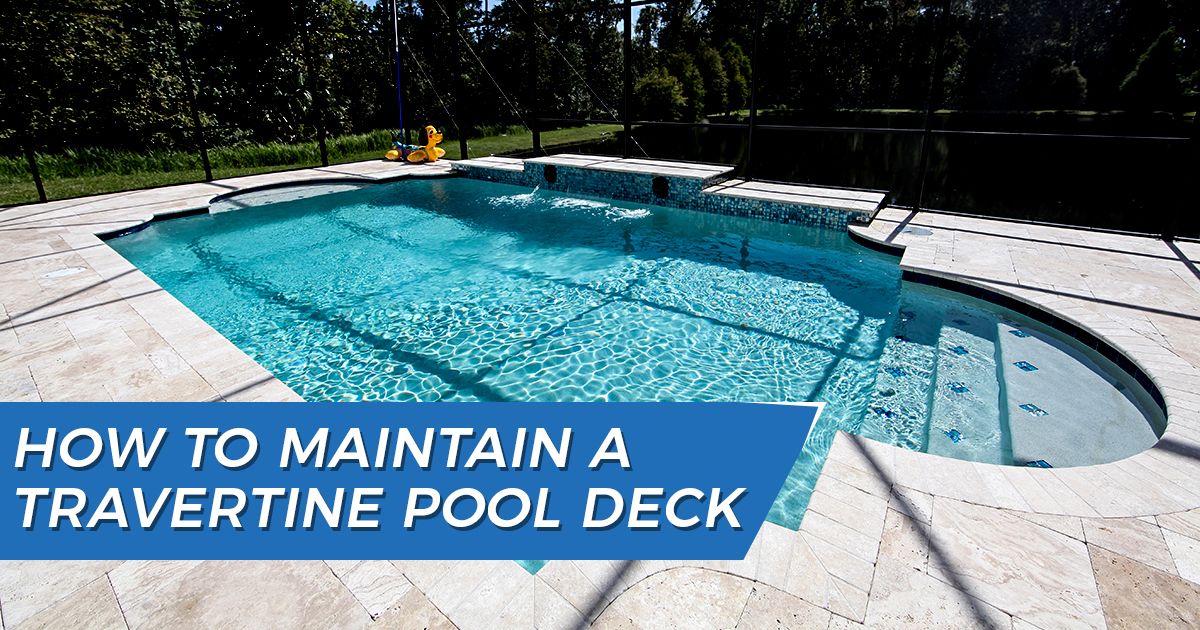How to Maintain Your Travertine Pool Deck
Travertine is a warm stone commonly found in some of the most beautiful pool decks in Florida. As a decking material, it’s desirable because it’s durable and long-lasting, and it requires little maintenance. Of course, no decking material is completely maintenance-free, and travertine is no different.
If you’d like to install travertine stone near your backyard pool, or if you already have a travertine deck, there’s much to learn about maintaining this stone’s natural beauty. Learn what to do to take care of your pool deck. With proper care, including cleaning, sealing, and occasional repair, your travertine can last for many years.
Related Article: Travertine vs Brick Pavers for Your Pool Deck
Maintaining Your Travertine Pool Deck General Cleaning
To maintain a travertine pool deck, sweep the travertine regularly. This prevents dirt from building up on the stone and staining it. Periodically, clean your travertine with a natural stone cleaner. Don’t use anything acidic (like vinegar), and don’t use bleach. If using natural stone cleaner, follow the manufacturer’s instructions. Repeat the use of natural stone cleaner as needed.
Reseal Travertine Pavers Periodically
 Your travertine pool deck tiles need to be resealed periodically to avoid stains or damage from water. Check the instructions on your sealing product to find out how often it needs to be applied. Not sure if your travertine tiles are properly sealed? Drop a few beads of water onto the stones. If the water is absorbed into the stone, it needs to be resealed. If the water sits on top of the stone and beads up, then it doesn’t need to be resealed. To reseal your travertine tile:
Your travertine pool deck tiles need to be resealed periodically to avoid stains or damage from water. Check the instructions on your sealing product to find out how often it needs to be applied. Not sure if your travertine tiles are properly sealed? Drop a few beads of water onto the stones. If the water is absorbed into the stone, it needs to be resealed. If the water sits on top of the stone and beads up, then it doesn’t need to be resealed. To reseal your travertine tile:
- Clean the travertine according to these instructions.
- Allow the travertine to dry for 24 hours.
- Read the sealer instructions to reseal your travertine and apply as directed.
Pro tip: Buy exterior-grade natural stone sealer, not interior-grade.
Travertine Pool Deck Maintenance – What to Do About Stains
Stains can happen, especially if your tiles aren’t properly sealed. To remove the stains from your backyard tile, follow these instructions.
First, you’ll need a poultice. A poultice is a stain remover that can be applied straight to your stone. Poultices are sold commercially, so you can buy a poultice from a stone dealer. You can also make your own poultice by combining baking soda and natural stone cleaner. Mix it until it’s a thick paste and spread the poultice over the stone.
Spread plastic wrap over the poultice and leave it in place for 24 hours; then remove the plastic covering and sweep away the poultice. If the poultice hasn’t completely absorbed the stain, repeat the process.
Related Article: Travertine Pavers: Are They the Best Pool Deck Option?
Can You Pressure Wash Travertine Pavers?
Yes, travertine can be lightly pressure washed, if the general cleaning practices listed don’t work on your pool deck. Use a light pressure wash setting only.
If you’re not familiar with pressure-washing tools, don’t want to rent a pressure washer of your own, or don’t feel comfortable cleaning your travertine pool deck this way, turn to a pool contractor. Your pool deck contractor can help you clean your travertine tiles without damaging your pool deck.
After pressure washing, your travertine tiles may need to be resealed. Purchase stone tile sealer for natural stone and follow all the manufacturer’s recommendations.
Travertine Paver Crack Maintenance
Small cracks in your travertine can get bigger with time if they’re not repaired and should be part of maintaining your travertine pool deck. This task can be done by a contractor or you can perform it yourself if you feel comfortable with DIY projects.
For this project, you’ll need to find natural stone filler epoxy or caulking. Look for a product that matches your travertine’s color perfectly. Whichever product you choose, be sure to look for something that’s designed for natural stone. If you’re not sure which product is best, ask your pool deck repair person for advice.
- Use a natural stone cleaner to wash your travertine. Follow the instructions provided by the manufacturer.
- Allow the stone time to dry overnight to ensure it’s completely dry when the repair occurs. If the stone gets wet overnight, wait for dry weather and try again.
- Insert a nail file into the crack and rub the sides of the crack up and down to rough up the surface. This helps create a surface the epoxy can grab onto.
- Use a vacuum to suck out the dirt and stone powder from the cracks.
- Mix the epoxy according to the manufacturer’s instructions.
- Insert the epoxy into the crack in the travertine, either using a toothpick, a putty knife, or something similar.
- Scrape up the excess filler with the putty knife, and smooth down the surface of the putty.
Related Article: Pool Decking Options for Your Renovation Project
Maintaining Your Travertine Pool Deck with GPS Pools
If you clean your travertine tiles on a regular basis, you shouldn’t need much help from a contractor to repair or replace them. However, travertine pool deck maintenance is so important that if your travertine tiles have been neglected or simply haven’t weathered well, you’ll need a pool contractor to help. Your pool contractor can replace damaged tiles or may recommend a full renovation of your pool deck area.
At GPS Pools, we help homeowners like you decide which course of action is right for your backyard pool. We can help you evaluate the condition of your pool deck. If we decide that your pool deck needs replacement instead of repair, we can provide a quote to get you started.
We serve the communities of Odessa, Pebble Creek, Tampa Palms, Wesley Chapel, Seven Springs, Keystone, Lake Fern, and more, from our locations in New Tampa, Land O’Lakes, and Lutz. Performing premium quality pool deck resurfacing and remodeling services for over 20 years. Want to know more about repairing your travertine pool deck? Contact us to learn more today.

